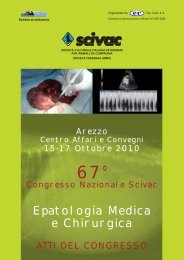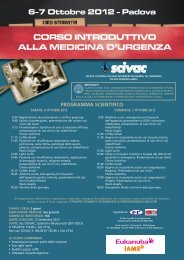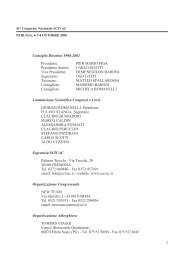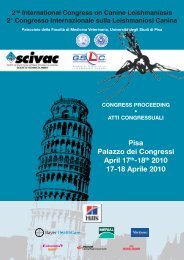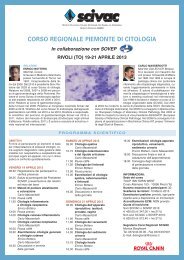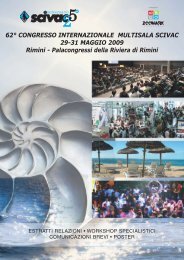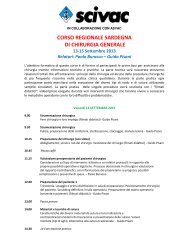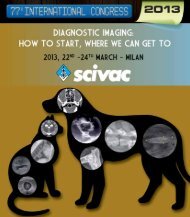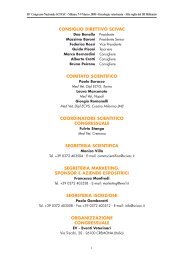68° Congresso Nazionale SCIVAC: Le domande più frequenti in ...
68° Congresso Nazionale SCIVAC: Le domande più frequenti in ...
68° Congresso Nazionale SCIVAC: Le domande più frequenti in ...
Create successful ePaper yourself
Turn your PDF publications into a flip-book with our unique Google optimized e-Paper software.
<strong>68°</strong> CONGRESSO NAZIONALE <strong>SCIVAC</strong> 11-13 Marzo 2011 - Milano<br />
LE DOMANDE PIÙ FREQUENTI IN RIPRODUZIONE CANINA E FELINA<br />
Tutto quello che i vostri clienti osano spesso chiedere e a cui voi non sapete rispondere<br />
14 th EVSSAR Congress - Advances <strong>in</strong> Fel<strong>in</strong>e Reproduction - March 11 th 2011<br />
quently <strong>in</strong>duce oestrus <strong>in</strong> anoestrous animals. In the past, only <strong>in</strong>jectables<br />
forms were available on the market, and the daily adm<strong>in</strong>istration process did<br />
not make it pratical enough for rout<strong>in</strong>e use. At the beg<strong>in</strong>n<strong>in</strong>g of the 21 st century,<br />
biocompatible implants allow<strong>in</strong>g daily delivery of these drugs were developed<br />
and used <strong>in</strong> the mare, the cow and the bitch (Trigg 2001). Promis<strong>in</strong>g<br />
results were obta<strong>in</strong>ed, as Kutzler (2005) and Volkmann et al (2006) reported<br />
heat and ovulation <strong>in</strong>duction <strong>in</strong> all treated animals with implants deliver<strong>in</strong>g<br />
25μg per day of the GnRH agonist deslorel<strong>in</strong>. Heats were <strong>in</strong>duced 3 to 5 days<br />
after implant adm<strong>in</strong>istration. Moreover, pregnancy results that were obta<strong>in</strong>ed<br />
(5/8 -62%- bitches from Kutzler et al, 9/13 -69%- from Volkmann et al)<br />
opened <strong>in</strong>terest<strong>in</strong>g perspectives for the future. However, these results were<br />
ma<strong>in</strong>ly obta<strong>in</strong>ed <strong>in</strong> anoestrous beagle bitches housed <strong>in</strong> research colonies, and<br />
few data from the field are actually available.<br />
In a recent study conducted <strong>in</strong> our cl<strong>in</strong>ical division (Fonta<strong>in</strong>e et al. 2010),<br />
32 bitches consult<strong>in</strong>g for heat <strong>in</strong>duction were observed. Two groups were differentiated:<br />
group 1 (G1), where bitches were implanted 80 to 160 days after<br />
the last heats were observed (G1; n=8) and group 2 (G2, n=24) where bitches<br />
were implanted <strong>in</strong> late anoestrus 200 to 590 days after.<br />
Oestrus <strong>in</strong>duction was obta<strong>in</strong>ed <strong>in</strong> all 32 bitches, 4.3±1.4 days after implantation<br />
[from 2 to 7 days]. Ovulation was observed <strong>in</strong> 25/32 bitches<br />
(78.1%) 11.8+/-2.1 days after implantation. Statistical analysis showed no<br />
difference <strong>in</strong> age and size of ovulat<strong>in</strong>g and non ovulat<strong>in</strong>g bitches. 3/8 bitches<br />
(37.5%) implanted <strong>in</strong> G1 did not ovulate, whereas it only concerned 4/24<br />
bitches (16.7%) implanted <strong>in</strong> G2. Pregnancy was diagnosed <strong>in</strong> 18/24 bitches<br />
(75%). No statistical difference concern<strong>in</strong>g the age, the size and the time of<br />
implantation of pregnant and non pregnant bitches could be enlightened.<br />
3.2. IN THE QUEEN<br />
In the queen, hormonal protocols of oestrous <strong>in</strong>duction are not ideal at the<br />
moment, as dopam<strong>in</strong>ergic compounds seem to have a weak and <strong>in</strong>constant<br />
efficacy, gonadotrop<strong>in</strong>s (although widely used) may bear undesired side effects<br />
and GnRH agonists implants are still be<strong>in</strong>g studied. Queens be<strong>in</strong>g highly<br />
sensitive to light, manipulation of photoperiod seems nowadays to be one<br />
of the most effective and safe way to <strong>in</strong>duce oestrus <strong>in</strong> anoestros queens, especially<br />
<strong>in</strong> the non-breed<strong>in</strong>g season. Catteries hav<strong>in</strong>g sufficient lighten<strong>in</strong>g 14<br />
hours a day (enough to read a newspaper without effort) help the queens to<br />
cycle all year long.<br />
42



